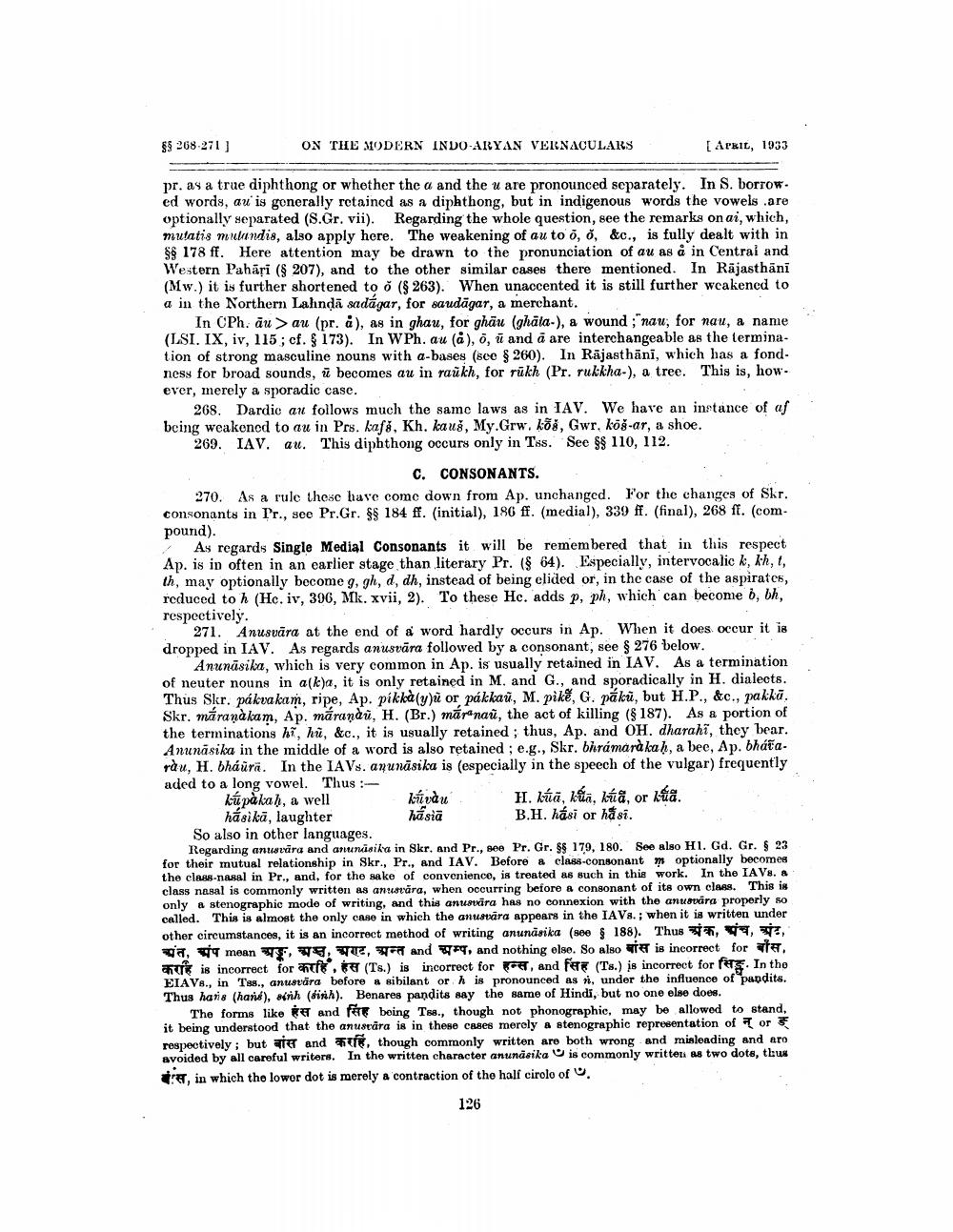________________
ON THE MODERN INDO-ARYAN VERNACULARS
§§ 268-271 ]
pr. as a true diphthong or whether the a and the u are pronounced separately. In S. borrow. ed words, au is generally retained as a diphthong, but in indigenous words the vowels are optionally separated (S.Gr. vii). Regarding the whole question, see the remarks on ai, which, mutatis mulandis, also apply here. The weakening of au to o, o, &c., is fully dealt with in §§ 178 ff. Here attention may be drawn to the pronunciation of au as å in Central and Western Pahari (§ 207), and to the other similar cases there mentioned. In Rajasthānī (Mw.) it is further shortened to ō (§ 263). When unaccented it is still further weakened to a in the Northern Lahnda sadágar, for saudagar, a merchant.
In CPh. au>au (pr. å), as in ghau, for ghau (ghala-), a wound; nau, for nau, a name (LSI. IX, iv, 115; cf. § 173). In WPh. au (a), o, u and a are interchangeable as the termination of strong masculine nouns with a-bases (see § 260). In Rajasthäni, which has a fondness for broad sounds, u becomes au in raukh, for rukh (Pr. rukkha-), a tree. This is, however, merely a sporadic case.
[APRIL, 1933
268. Dardic au follows much the same laws as in IAV. We have an instance of af being weakened to au in Prs. kafs, Kh. kauš, My.Grw. koš, Gwr. kös-ar, a shoe.
269. IAV. au. This diphthong occurs only in Tss. See §§ 110, 112.
C. CONSONANTS.
270. As a rule these have come down from Ap. unchanged. For the changes of Skr. consonants in Pr., see Pr.Gr. §§ 184 ff. (initial), 186 ff. (medial), 339 ff. (final), 268 ff. (compound).
As regards Single Medial Consonants it will be remembered that in this respect Ap. is in often in an earlier stage than literary Pr. (§ 64). Especially, intervocalic k, kh, t, th, may optionally become g, gh, d, dh, instead of being elided or, in the case of the aspirates, reduced to h (He. iv, 396, Mk. xvii, 2). To these Hc. adds p, ph, which can become b, bh, respectively.
271. Anusvara at the end of a word hardly occurs in Ap. When it does occur it is dropped in IAV. As regards anusvära followed by a consonant, see § 276 below.
Anunäsika, which is very common in Ap. is usually retained in IAV. As a termination of neuter nouns in a(k)a, it is only retained in M. and G., and sporadically in H. dialects. Thus Skr. pákvakam, ripe, Ap. pikka (y) or pákkau, M. pike, G. paku, but H.P., &c., pakka. Skr. maranakam, Ap. marandu, H. (Br.) maranau, the act of killing (§ 187). As a portion of the terminations hi, hu, &c., it is usually retained; thus, Ap. and OH. dharahi, they bear. Anunasika in the middle of a word is also retained; e.g., Skr. bhrámarakaḥ, a bee, Ap. bhátarau, H. bháura. In the IAVs. anunāsika is (especially in the speech of the vulgar) frequently aded to a long vowel. Thus :
kúpakaḥ, a well
hásikā, laughter
kúvàu hasia
H. kúa, ka, kúa, or kua. B.H. hási or hasi.
So also in other languages.
Regarding anusvära and anunäsika in Skr. and Pr., see Pr. Gr. §§ 179, 180. See also H1. Gd. Gr. § 23 for their mutual relationship in Skr., Pr., and IAV. Before a class-consonant m optionally becomes. the class-nasal in Pr., and, for the sake of convenience, is treated as such in this work. In the IAVs. a class nasal is commonly written as anusvära, when occurring before a consonant of its own class. This is only a stenographic mode of writing, and this anusvära has no connexion with the anusvära properly so called. This is almost the only case in which the anusvāra appears in the IAVs.; when it is written under other circumstances, it is an incorrect method of writing anunäsika (see § 188). Thus,, अंत, अंप mean अङ्क, असु, अण्ट, अन्त and अम्प, and nothing else. So also बांस is incorrect for बाँस, करहि is incorrect for करहिं हंस (Ts.) is incorrect for हन्स, and सिंह (Ts.) is incorrect for सिद्ध. In the EIAVS., in Tss., anusvära before a sibilant or his pronounced as i, under the influence of pandits. Thus hans (hané), sinh (dinh). Benares pandits say the same of Hindi, but no one else does.
.
The forms like and fer being Tss., though not phonographic, may be allowed to stand, it being understood that the anuseara is in these cases merely a stenographic representation of or respectively; but air and f, though commonly written are both wrong and misleading and aro avoided by all careful writers. In the written character anunäsika is commonly written as two dots, thus , in which the lower dot is merely a contraction of the half circle of
126




